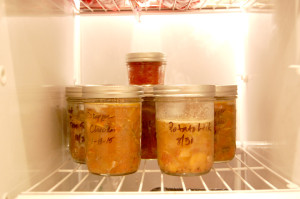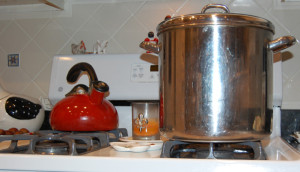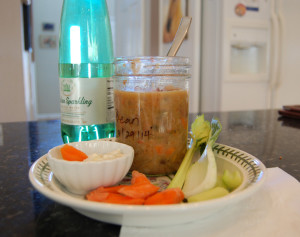My conversion from typical American food to traditional, organic and nutrient-dense foods (thanks to The Weston Price Foundation and Nourishing Traditions) has been a steady and educational path for several years. Growing up during the 60s and 70s, I accepted the constant introduction of new convenience foods—and was lulled by the belief that our government (FDA, DOA, et al) would never allow unhealthy foods into the American diet. My thinking was: if we can buy it, it has passed rigorous testing and it must be safe and healthy for us to consume. That’s what they told us. I don’t believe that any more. My eyes have been opened by countless books and articles (thanks to this information age) on when it comes to anything, even our food, money talks. Large corporations, having deep pockets, employ lobbyists and even grease some political palms from time to time to pass laws in their favor. And often pay government agents to look the other way when they’re on shaky ground. Conspiracy theory? I’ve heard enough confessions and seen enough connections to trust that it’s real. And I read labels.
But… now on to the topic of no more cans! Since I bought a pressure canner a couple of years ago, a whole new world of food preservation has opened up for me. Alleviating my concerns of spoilage, and expanding the types of foods I can “can,” I’ve stopped buying canned foods altogether and started making my own. Stored in glass jars, not cans.
Don’t have the time, desire, ability or nerve to do your own canning? You can still freeze foods, and when frozen in glass, it will keep for a much longer time than plastic containers or bags. Plastic may not look like it, but it’s porous and all the moister will eventually get sucked out of your frozen foods that are stored in plastic. Freezer burn. Then there’s always the question of BPAs leaching out of the plastic into your foods, especially if you use a microwave to defrost them.
No surprises here: I consider soup to be the perfect food. How many other types of food can contain all of the food groups in one convenient pot? You can load a dutch oven, even a crock pot, with a variety of healthy fresh vegetables, herbs, maybe a little meat and some stock (remember “stone soup?”) and simmer them to fragrant perfection. Hey, this way you can even get the kids to “eat their veggies” if you do it right. Talk about a super food!
When I started canning again and buying lots of jars, I learned that wide mouth pint canning jars are freezer safe. It says so right on the label. The shape of the wide mouth jar doesn’t have the “shoulders” that a regular mouth jar has, so when you freeze something in them and the contents expand, they won’t crack the jar. Now when I make soup, I make more than I need and ladle the leftovers into those jars (leaving 1” airspace) and pop them in the freezer—a quick nutritious meal to be enjoyed another day and it will taste as fresh as the day I made it.
Yes, I know I can buy canned or frozen soups at the store. Duh. But between all the nasty chemical preservatives, BPAs, lab-made salt, thickeners and flavor enhancers in canned soups and with metal cans containing BPAs (I heard they’re even spraying the inside of cans with MSG to disguise the metallic taste!), I’ve stopped buying canned anything. There are companies now that are using BPA-free cans, such as Amy’s Organics, and it will say so right on the can. You can find a list of other non-BPA canned products here. But freezing your own soup means you have a variety of soups that you LOVE, that are not necessarily available in stores. Also, you’ll be using your jars over and over again, so there’s zero environmental impact. You’d be saving the planet! Or, well, at least creating less of a footprint. Ahem.
Additional notes:
- I’m sure I don’t have to say this, but please wash your jars, lids and bands before using them. Hot soapy water is fine.
-
News flash: You can reuse canning jar lids! If you are canning something, you always need to use new lids to ensure a proper seal. But if you’re just freezing stuff, or storing something in the pantry, you can reuse the lids. It’s not a problem. Really.
- If you decide to try freezing soups, please make sure you leave at least 1” for “headroom” when filling the jars. The soup will expand as it freezes and will make a little soup volcano in the middle of the jar. If you don’t leave room for this expansion, you will most likely end up with a broken jar.
I like to heat up my soup pot, put the soup in the jars hot, add the lids and let them cool a bit before putting them in the freezer. I write the contents & date in Sharpie on the glass jar. It’s easy enough to remove when you wash the jar later on. The other day I had a soup that I’d canned 9 months ago and it was as good as the day I made it.
-
To defrost, I take the band and lid off (I run them under a faucet if they’re stuck) and then put the jar in the microwave, a minute at a time, until I can pour the contents into a pot for complete heating. If you’re not anti-microwave, you can continue to heat the soup (stirring occasionally) in the microwave until it’s ready to eat, and then eat right out of the jar. Just rubber band a paper towel over the top to prevent splattering when heating. If you work in an office, you can pull a jar of soup in your freezer a night ahead of time for the next day’s lunch, keep refrigerated and then heat it up in the office microwave.








